- About
- Subscribe Now
- New York,
July 26, 2018
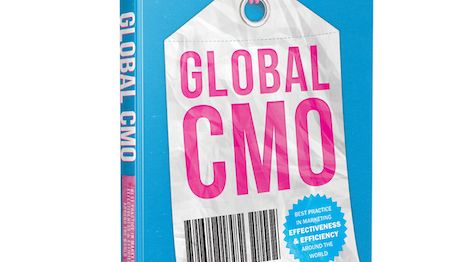
 Other C-Suite titles are rapidly chipping away at the CMO's duties and responsibilities
Other C-Suite titles are rapidly chipping away at the CMO's duties and responsibilities
By Greg Paull and ShuFen Goh
This chapter was excerpted with permission from "Global CMO: Best Practice in Marketing Effectiveness & Efficiency Around the World."
Taking on the Competition
Chief marketing officers are facing two types of competition in today’s landscape. The first is external competition, or the competition facing the organization in terms of market share and business results. In this wave of digital disruption, most organizations are facing competitors that they didn’t have ten years ago — Airbnb challenging traditional hotels, Venmo and Apple Pay challenging big banks, and online streaming services challenging traditional cable companies. The second form of competition is internal, or the challenges posed to CMOs by the rise of new C-suite executives as organizations struggle to build digital capabilities and own their consumer journey.
The Evolution of The Competitive Landscape
While this advent of digital disruption may seem sudden, the movement can be traced back to 1995, when the term first popped up in the Harvard Business Review as “a process whereby a smaller company with fewer resources is able to successfully challenge established incumbent businesses.” Back then, it was the music, photography and video rental sectors that were feeling the burn from digital start-ups like MySpace, Apple and Google. Fifteen years later, digital innovation advanced in another wave, and the print media, television and travel industries were shaken up by Airbnb, streaming videos, and travel Web sites.
“Media was one of the first industries to be disrupted largely because, at the time, media companies gave away their content for free on the Internet without recognizing the value they were giving away. Once that genie was out of the bottle, there was no going back,” says Maryam Banikarim of Hyatt Hotels. “Disruption comes fast and furious. And it comes when you don’t expect it. Just look at what’s happening in retail today. So we are on the lookout, as much as we can be, for disruption to come our way too.”
 Waves of digital disruption
Waves of digital disruption
Starting in 2015, the finance, healthcare, automotive, retail, education and telecommunications industries found themselves playing catch-up in the face of online banking, Venmo and even WeChat.
“Digital disruption has certainly been more present,” says Jennifer Breithaupt, global consumer chief marketing officer of Citi. “Really, for us, mobile banking and the future deployment of omnichannel banking is critical. When you think about using tools like mobile, as well as digital payment tools, social media, video tellers, really all of those things that have more of a self-service model, that’s where the disruption has come into place. We’ve had to really fast-track how people interact with us, how they bank with us, and how we become the bank of the future.”
Even industries that many would assume haven’t been affected by digital disruption are feeling the pressure and starting to prepare for the future.
“Disruption is something that we have talked about on many occasions,” says Linda van Schaik of Shell. “At the moment, we are seeing certain trends that have caused us to start thinking and testing. Things like car sharing and autonomous driving. These will probably lead to a shift from a B2C [business-to-customer] to B2B [business-to-business] type of customer relationship. It’s definitely disruption based on digitalization.”
By 2020, there will be no industry — however stolid, set or ingrained — that will remain a safe haven from digital disruption.
In a survey by Dell of 4,000 business leaders, 78 percent believe digital start-ups pose a threat to their organization now or in the near future, and 62 percent have seen new competitors enter the market as a result of the emergence of digital technology.
“We are actively seeing disruption happening across our entire supply chain, from branding to manufacturing to distribution,” says Francisco Crespo of Coca-Cola. “We are seeing a proliferation of new entrants in the North American ready-to-drink [NARTD] space able to launch and scale at an increasingly fast pace. Traditional barriers to entry are no longer the issue given advancements in data and technology.”
 Digital competition and the CMO
Digital competition and the CMO
Peter Nowlan of Four Seasons Hotels and Resorts explains how it has been able to stay ahead of disruption: “Whether we talk about industry consolidation, emerging technologies, or new players in the market, the bottom line is most of these disruptors are grounded in evolving consumer behavior. Our brand belief has always been based on service, the people who deliver that service, and the relationships we have with our guests. Therefore, we’ve been able to stay ahead of change by sticking to what we know best and using the impact of disruptors to our advantage.”
This restructuring of the world business order has been on the horizon for more than two decades and, in order to change with the times, brands need to work overtime to cure the “legacy disease” that still seems to affect many companies, especially in established markets like the United States.
Many continue to drag their feet, moving slowly (or not at all) to transform internal systems and external practices. These organizations need to adopt the strategy of “learn, unlearn and relearn,” which is crucial for both promoting digital transformation and building sustainable integration.
“The challenge is not the learning curve. The challenge is the ‘unlearning’ curve,” says Mukul Deoras, global chief marketing officer of Colgate-Palmolive. “To me, that is the biggest hurdle. How do you get off the horse you’re riding so that you can get onto another one?”
Many marketers have already taken drastic steps to change internal legacy processes and systems. One of those steps is breaking down internal silos to make sure there is a heightened level of cross-team functionality.
“The old days of ‘IT is over here’ and ‘marketing is over there’ and you’re fighting and saying, ‘Why didn’t you bring me in soon enough?’ It literally feels like another lifetime to me,” says Linda Boff of GE.
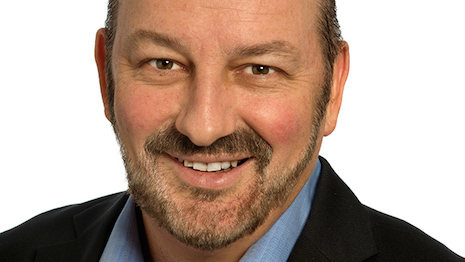 Greg Paull is cofounder/principal of R3 Worldwide
Greg Paull is cofounder/principal of R3 Worldwide
Changing Mindsets is Key
The first step in the transformation is moving away from the mindset that there is a difference between digital and traditional businesses.
Eighty percent of the 700 CMOs interviewed in a C-suite study by IBM believe the business landscape will change “to include more digital, virtual interaction in three to five years.”
Mukul Deoras of Colgate-Palmolive explains, “My biggest challenge is breaking out of the comfort zone of the old way of doing things — whether they’re right or wrong. That comfort came with the knowledge of certain measurements. Those measurements were a crutch on which we based much of our consumer engagement strategy. Very simplistically put, whether a [gross rating point] GRP thrown into the market made a difference wasn’t very clear. As they say, half of it worked — we didn’t know which half, but we certainly knew that half of it worked — and we just lived with that, as long as we measured enough.”
This is no longer enough. The new reality is that disruptive digital models are popping up across industries. It’s not just about competition from digitally native start-ups. Existing suppliers, former partners, and current competitors who are able to use new technologies to augment and fragment the traditional value chain are creating fresh competition from every side, meaning everyone has to innovate in order to even the playing field.
Global CMOs, Disrupted
As industries work to restructure the way their company is arranged and how to define the business, CMOs must also consider how they will evolve their own role within the company to ensure continued relevance within the organizational structure.
In the eyes of Raja Rajamannar, chief marketing officer of Mastercard, the role of today’s marketer should be viewed much more within the realm of general manager than the marketers of yesteryear.
Mr. Rajamannar explains:
“Companies have three big lines of spending: technology, people and marketing. When CEOs are running short on revenue, they are more likely to pull money from the marketing department because the immediate impact of marketing is not always seen or appreciated by many CEOs. When asked a tough question, because marketing people have come from the creative route, they struggle with numbers. And in that kind of scenario, they lose their credibility. They lose their budgets.”
CMOs are also facing new challenges in the C-suite, as new titles crop up in the wake of digital transformation. Some view these new executives as a threat to CMOs because they are encroaching on, and overlapping with, their established territory.
Ten years ago, there were no chief digital officers, chief growth officers or chief experience officers. However, the rise of the new C-suite executives isn’t necessarily a negative for CMOs.
For example, at Citi, the chief customer and digital experience officer and the CMO’s teams work hand in hand.
“It’s really important that we stay connected,” says Jennifer Breithaupt of Citi. “The good news is we, and our teams, sit very close together, and we are all aligned around the same goals and priorities. It’s been a truly amazing, collaborative partnership and one that is critically important as it relates to the end-to-end customer experience.”
Others see the rise of these new C-suite executives as a direct conflict with the existing role of the CMO.
“When you have a chief digital officer, chief customer experience officer and chief revenue officer, what is marketing supposed to do if they no longer handle any of those components?” says Raja Rajamannar of Mastercard. “That is an existential threat to the CMO at one level.”
To some extent, it makes sense for CMOs to be a little wary of this new competition, as there are several possible trajectories for the CMO going forward, and not all of them are positive.
Up or Over; Down and Out
As organizations focus on driving growth, the Harvard Business Review published an article that outlined four possible futures for CMOs: up, over, down or out. Each of these possible futures has different implications for marketing teams and organizations as a whole.
In an upward trajectory situation, CMOs are promoted into new and bigger roles that feature a larger focus on end-to-end consumer experience. For example, KFC’s former U.S. CMO was recently promoted to the role of president and chief concept officer, responsible for driving overall strategy and business performance, and reflecting the importance placed on marketing being able to move the business needle figure:
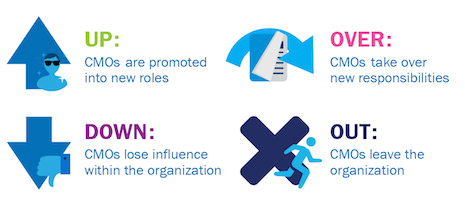 Up or over, down and out
Up or over, down and out
A prime example would be Airbnb’s former CMO, Jonathan Mildenhall, who sought to leverage technology to give a whole new meaning to experiential marketing while simultaneously transforming Airbnb from a tech company to a full-fledged travel brand.
The two other possible trajectories are less savory.
First, within their company, CMOs can begin to lose influence with the aforementioned rise of the new C-suite executives, with fewer responsibilities and less opportunity to make real change within the organization.
Then, there is the possibility that the company no longer leaves space for a CMO within the organizational structure at all. Coca-Cola recently went this route, eliminating the position altogether in favor of a chief growth officer.
According to Forrester Research, some 30 percent of CEOs might fire their CMO in 2017 for lacking the skills necessary to pull off digital business transformation. CMOs are first in the firing line if business growth targets are not met (followed closely by chief sales officers and chief strategy officers), an Accenture Strategy study found.
Fight the Competition: Adopt a Start-up Frame of Mind
To directly address digital disruption and competition, CMOs must adapt both their role and that of their team so that they are set up to innovate in a way that adds tangible value. This evolution can come in a myriad of ways.
First off, re-programming the legacy mentality and the CMO role both require returning to a start-up state of mind, no matter how long your company has successfully been in business.
“One of the most important things to remember as a market leader is that we must continually challenge the status quo. Even if we are ahead of our competitors at a point in time, we know that something else is going to happen, and we know that a change is going to come from someone else challenging the business model, challenging the technology base, or whatever else,” says David Roman, chief marketing officer of Lenovo.
“We would rather be the challenger, and so we really never take that leader mindset of saying, ‘Okay, now we can, in some respect, control the businesses market.’ We assume that we can’t," he said. "We have to continue to challenge ourselves and so I think the challenger mindset is crucial to survival. The challenger mindset is the only thing that will keep you in business.”
Invest in Incubators and New Platforms
Another way to tap into this start-up attitude is to look for different types of incubators and partners that will drive innovation and allow the parent company to learn and absorb through proximity and experience. Coca-Cola is building new capabilities by reaching out to those more digitally capable.
“We are smart enough to know what we don’t and take the opportunity to learn from partners and start-ups. Coca-Cola was a founding member of an incubator called The Bridge, which essentially looked to help the best and brightest start-ups in Tel Aviv shorten their maturity curves and build products and services that could be consumed by large scale CPGs (consumer packaged goods) and beyond,” says Francisco Crespo of Coca-Cola. “Since inception, we have expanded locations across North America, Latin America, and Asia-Pacific, successfully graduating dozens of companies annually. In addition, we constantly are challenging our large-scale media, technology, and content partners with pilots to help us fail fast, but learn quickly.”
Mars has also recently created an innovation lab through a collaboration initiative called Launchpad. Mars CMO Andrew Clarke explains that the initiative encourages each local market to pitch ideas focused around the demand challenges that they need to solve using data and technology. Then working with Mediacom and segment CMOs, Mars looks at all of those briefs and picks the best ones. Three times a year, it will pick around ten at a time, and then look to partner them up with a start-up business externally.
Mr. Clarke explains:
“The objective of this really is twofold. One, I think it is a great way to incubate and experiment with new ideas that we’ve probably not thought of before. The second reason for doing it, frankly, is to really help to bring some external talent into Mars so that the digital IQ we can get from start-ups helps to educate and upskill our own associates in our local markets and vice versa. What we can offer start-ups really is the scale and the ability to bring our expertise around big brands — how we reach consumers at scale very quickly. If we can get those partnerships to really work, then there’s a real mutual benefit in it for us as we learn and upscale our teams in digital as well as potentially start-ups getting access to our capabilities. That’s very, very exciting.”
To get to the right people, other brands have focused on loyalty programs, shaping their brand so that it reacts and is exclusive to customers who keep coming back.
Maryam Banikarim of Hyatt Hotels says her company wanted to reimagine the loyalty program, but also wanted to discover experiences that would help differentiate Hyatt from the rest of the pack.
“Hyatt is not about size for the sake of size. We’re about growing with focus to super-serve the high end of the market and the places that matter most to our targeted guests,” says Ms. Banikarim. “We leverage the advantages that come from being smaller than our larger competitors yet bigger than the boutiques. We want to use our size and scale to quickly respond to the changing marketplace, knowing our customers better than our competition, and over-performing in each of the segments we’re in.”
Ms. Banikarim continues:
“In addition to maximizing core business, our strategy is to build, partner, or buy in the areas such as wellness, food and beverage, and alternative accommodations to expand our brand across more dimensions of our travelers’ lives. After doing a good deal of analysis we decided to enter the wellness market. Consumers are increasingly looking for ways to be well when at home and on the road and we identified white space in the mindfulness category that we thought presented us with an opportunity. Consumers told us they wanted us to move in this space, but we recognized the need to enter the category with brands that brought an inherent wellness expertise. In 2017, we acquired Miraval, the renowned provider of wellness and mindfulness experiences, and Exhale, the well-being brand that addresses mind and body through spa and fitness. Miraval and Exhale’s unique, mindful-centered philosophies are what drew us to those acquisitions.”
Invest in New Technologies
In addition to learning from new acquisitions and incubators, it is also important for companies to invest directly and thoughtfully into technology.
GE has done a particularly good job transforming itself from an industrial company into a digital industrial company. As was mentioned in the previous chapter, five or six years ago, the company dove into their strategy to make software the center and brought on all kinds of data entrepreneurs and data scientists to really build out a full value proposition for industrial companies that are trying to monitor their assets remotely—an industrial platform called Predix. To communicate this new advancement, GE launched the Owen campaign, which brought a human and humorous face to a very real technological advancement for GE.
“From a marketing point of view, what we try to do is find ways to bring that new ethos to life,” says Linda Boff of GE, “in terms of what we say, where we say it, and how we say it.”
It also merged interaction and engagement with technology, as GE has experimented with and organically embraced new platforms into its marketing system as they emerge, like Snapchat, Instagram, Periscope, and other social technologies. While new social tech does not work for every project or company, finding out how to build social into a company identity helps it to reach out to and communicate with a broader and more engaged audience.
In the financial sector, Bank of America is also leading the charge on how financial institutions need to rethink the way it does business.
By the end of 2017, Early Warning, in collaboration with major banks like Bank of America, is set to have a large percentage of U.S. banks on the Zelle platform, enabling users to send and receive money across all different financial institutions. This is its answer to other peer-to-peer (P2P) platforms, but with the added support of a trusted bank holding the reins.
“This was our way of saying, ‘Listen. We know this is what the millennial population wants,’” says Meredith Verdone of Bank of America. “Millennials have been on other P2P platforms and we need to build a better mousetrap and [Zelle] is a better mousetrap in the sense it’s more secure, it’s free, and it’s simpler to use.”
“The difference is that we’ve got the size and the scale,” she continues. “We bank 16 million millennials, so we’ve got this tremendous scale and an ability to deepen with them. What’s fascinating — and this shocks people — is that millennials still come into financial institutions. They do! They still want to talk to humans, when it’s that moment that matters.” In 2015, Burger King invested in bringing together a group of engineers in-house to form their digital team, based out of New York, which drives the front of technology innovation in their organization.
“Their main goal is to connect the front of house with the back of house to improve the guest experience. Self-order kiosks are one of their priorities. Our mobile order and pay app is something they’ve been developing, and we’re actually testing it in our Miami market now,” says Axel Schwan of Burger King. “It’s also important for us to consider how all of these things connect to our POS [point of sale]. We want our front of house to connect to the back of house in a way that delivers a seamless experience for our guests.”
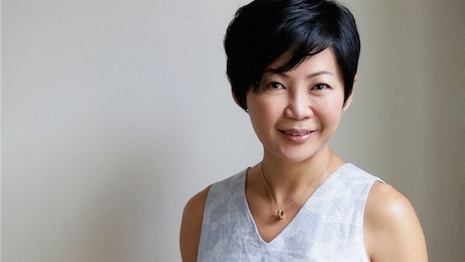 ShuFen Goh is cofounder/principal of R3 Worldwide
ShuFen Goh is cofounder/principal of R3 Worldwide
Know the Customer
In order to survive in the age of digital disruption, CMOs need to gear their digital transformation efforts toward developing ways to effectively engage customers through traditional channels and meet their rising expectations.
Customer-centricity is recognized as one of the main precursors to success.
Looking to customers for insight and understanding how to best employ technologies to meet those expectations will help companies relate to consumers whose expectations have indelibly been changed by services like Amazon, Airbnb and Uber.
The consumer market requires engagement and an “always on” experience.
“Consumers are dictating how, when and why they choose to purchase and consume a beverage, and that is requiring us to rethink our approaches to engagement and the experiences we create to engender loyalty,” says Francisco Crespo of Coca-Cola. “We think these disruptions are helping to fuel new innovations and business opportunities for CPGs that didn’t exist ten years ago, which result in value for both consumers and customers.”
This requires the effective utilization of technology that is with the consumer throughout his or her entire purchasing journey. It also requires the adaptation of an “outside-in” approach that allows you to see what is happening in the outside world of data and bringing it into the strategies and projects being worked on internally, as opposed to dictating to the outside world what you think they should be doing and thinking.
“No CMO will ever tell you their budget is big enough,” says Linda Boff of GE. “But to me, it’s really not about money. It’s about figuring out the places to strategically have an impact with the right people.”
CASE STUDY
Coca-Cola's Taste the Feeling
Background: Marking a significant shift in its marketing strategy, in mid-2016 Coca-Cola announced that for the first time, all of the Coca-Cola brands will be united in one global creative campaign: “Taste the Feeling.” This new brand platform replaced “Open Happiness,” which launched in 2009. The ads are all based around one core message, “The simple pleasure of drinking any Coca-Cola makes the moment more special.”
The initial campaign included TV spots, more than 100 campaign images, a new song developed by Avicii, and interactive digital advertising, and was rolled out in regional markets by local agency teams throughout 2016 with localized content under the “Taste The Feeling” umbrella.
Process: An international network of agencies developed the initial “Taste the Feeling” work. Four agencies — Mercado-McCann, Santo, Sra. Rushmore and Ogilvy & Mather — produced an initial round of ten TV commercials, digital, print, out-of-home and shopper materials with six additional shops contributing to creative as the campaign evolved.
Coca-Cola’s chief marketing officer at the time, Marcos de Quinto, who unveiled the “one brand” approach at a media event in Paris, asserted that the campaign underscores the company’s commitment to choice, offering consumers whichever Coca-Cola suits their taste, lifestyle and diet — with or without calories, with or without caffeine. The shift also represented a change in the overall business approach, with an increase in investment to market all Coca-Cola trademark products across the portfolio under one creative platform.
Results: In late 2016, Coca-Cola reported that early data coming in from the “Taste the Feeling” launch signaled “green shoots” for its one brand strategy. Coca-Cola’s president and chief operating officer said, “The early signs from the data are starting to look very encouraging, especially in those places where we launched first and we launched the fastest and the hardest. And we see encouraging results in terms of retail sales growth of the Coca-Cola brand in total.”
For the Olympic games in Brazil in 2016, Coca-Cola reached 20 million people every day, and their creative focused on “the incredible taste that we feel whenever we overcome, or whenever we win.” The result was a dramatic increase in brand feelings among their key teens target, driving their market share up by 1.5 percent and making Coca-Cola the most-associated brand with the Olympics.
Know What you’re Talking About
While it’s not possible for one CMO to know everything about everything, it is important for the CMO to know enough to ask the right questions. This helps interactions with the technology department, and to hire the right people.
A recent survey by Rocket Fuel and Forrester showed marketers are already embracing digital channels and marketing technology.
However, the rapid expansion of marketing tools has created a greater need for analysts and data scientists.
One in five respondents said a lack of analysts to manage emerging technology was a key barrier to adoption for multichannel attribution, cross-device delivery and tracking, and data management platforms.
To overcome this obstacle, it’s important for CMOs to be much more collaborative — to act more as network orchestrators than command-and-control executives.
Bringing in external resources (or leveraging internal ones) to help educate both leadership and the team on best practices is a key way to help transition both the role of the CMO and assist in the transformation of the company.
THE TYPES OF external resources marketing leaders are expected to turn to in the future aren’t necessarily the same traditional agency partners they’ve relied on in the past. The aforementioned Forrester study revealed that technology vendors will have a larger role to play.
Digital transformation is an ongoing process that takes time, training and effort. CMOs who face the external and internal competition head-on have a much greater chance at success than those who don’t play a proactive role in jumpstarting their organization’s transformation journey.
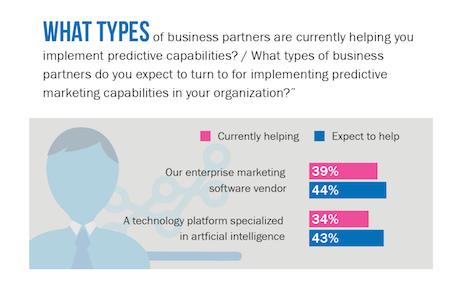 What types of business partners are helping?
What types of business partners are helping?
Greg Paull and ShuFen Goh are cofounders and principals of R3 Worldwide, a New York-based global marketing consultancy. Reach them at greg@rthree.com and shufen@rthree.com.
This chapter was excerpted with permission from "Global CMO: Best Practice in Marketing Effectiveness & Efficiency Around the World," Mascot Books, May 2018. Adapted for clarity and style.
Share your thoughts. Click here